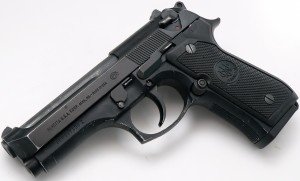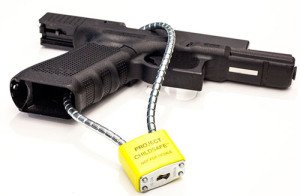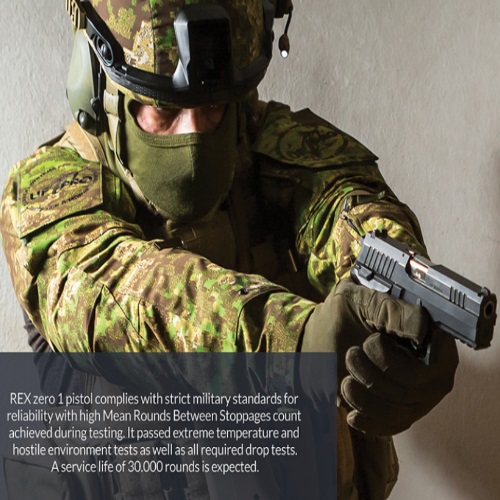Table of Contents
SIG has been making guns for over 150 years. SIG is actually an acronym, and it stands for Schweizerische Industrie-Gesellschaft (Swiss Industrial Company). In the 1970’s, following a change in Swiss gun-manufacturing laws, SIG created a partnership with Sauer & Sohn of Germany, which is how SIG & Sauer was born. This partnership has been a very successful one, spawning subsidiaries in Germany and the United States. In this SIG Sauer P226 Review we’ll take a closer look at one of SIG Sauers’ most popular offerings, the P226.
Brief History of The P226
The P226 model was developed in the mid 1980’s, as a competing design in a bid for a U.S. military contract. The P226 was an improvement of the P220, which was Germany’s service handgun. The P220 is a single stack gun, and it is chambered in .45.
SIG was looking to change things up for this bid, because the trend at the time was gravitating a lot more towards the 9mm cartridge. And so, SIG put in a bid with the P226, a full size, 9mm, double-stack handgun.

The company’s entry did not get them that contract, but it got very close to winning, surpassing several very popular brands on the way. In fact, the P226 came so close, that there were units (Navy SEALs and Texas Rangers, to name a couple) which decided to go with SIG’s model, even though the gun had failed to secure the coveted government contract. That plum went to the Italian Berretta company, and its 92F model.
Conspiracy theory time: it is suggested that the reason Italy got the nod from the U.S., was due to a semi-shady under-the-table kind of deal, whereupon Italy agreed to place U.S. missiles on its land, and play host to some U.S. military bases.
Like the Glock’s model 19 which I have previously reviewed (If you haven’t read it check it out here – Glock 19 Review), the P226 is considered by many to be SIG Sauer’s ‘SIGnature’ handgun. It is not hard to see why. It’s a great-looking gun, easy to operate, a breeze to maintain, and it is very accurate to boot. It comes in a variety of sub-models, so it is very easy to find a P226 which is just right for you.
The P226’s Specifications:
- Caliber – chambered in 9x19mm, but it also takes .40 S&W, .357 SIG, and .22 Long Rifle cartridges
- Length – 7.7 inches
- Height – 5.5 inches
- Width – 1.5 inches
- Weight – 34.0 oz. (including magazine)
- Barrel length – 4.4 inches
- Trigger pull – double action 10 lbs., single action 4.4 lbs.
- Magazine (9mm, standard) – 10 rounds
- Magazine (9mm, extended) – 15 rounds
- Magazine (9mm, optional) – 17/18/20 rounds
It’s What’s Inside That Counts

The P226 has no external safety mechanism. It is designed as a service pistol, and that means that it was created with the intention of being ready to fire at a moment’s notice. Draw, aim, shoot. This gun is one which is meant to be carried with a bullet in the chamber.
It is important to note that while the P226 does not have a safety switch or lever, it does have 4 internal (or ‘passive’) safety features, which are a part of the handgun itself:
1 & 2 – the de-cocker, and the safety intercept notch. It’s two for the price of one, so to speak. When the de-cocker is engaged, the gun’s hammer may be lowered safely. The notch makes sure that the hammer stays away from the firing pin, making it impossible for the gun to go off unintentionally, even with a round in the chamber.
3 – a third safety is the firing pin safety, which is also the gun’s drop safety. Unless the trigger is pulled, the firing pin will not move. This stays true, even when the pin is struck with significant force by the hammer. It is the trigger which disengage this safety feature.
4 – the trigger bar disconnector, located in the slide itself. There is a kind of lock built into the slide, which keeps the firing pin away from the chambered cartridge. The lock is disengaged only when the slide is in the proper position. This is a safety which comes into play when the gun is cycling, and it makes sure that no round is discharged before the gun has reset itself to its normal firing position.
The P226 has many variants, like a lot of other SIG models. Over 20 variants of the SIG P226 are still being produced and sold. Other ones have been produced in the past, but have since been discontinued. These variants differ in many ways, although they are all essentially the same P226. Some of them are merely engraved with a special insignia, or feature a different kind of finish. There are several P226s which sport more significant changes, such as the addition of night sights, a picatinny rail, grips, or a frame made of a lighter material. It should be noted that the P226 isn’t for shooters with smaller hands due to its trigger placement. There are modifications one could do to solve this problem but for those that would rather not bother there are a ton of different types of small handguns on the market to suit your needs. One such gun that I really love is my Glock 26, It’s super lightweight and efficient.
As stated earlier, SIG’s P226 is definitely an all-time favorite. It is the go-to gun for many a-shooter, and it constantly appears on various lists of popular handguns.
Making Its Mark World Wide
While the P226 may have not gotten that particular U.S. government contract, many military organizations and security forces have been using the SIG P226 ever since.
Some examples of countries and armed forces which use the P226:

- Bangladesh – Special Security Force, Navy
- Canada – Special Forces, Mounties, various police departments
- Finland – Finnish Army
- France – Tactical Squad of the French Gendarmerie
- Ireland – Army Rangers
- Israel – Special Forces
- Norway – Emergency Response Unit
- Netherlands – Netherland Marine Corps
Portugal’s Armed Forced, Singapore’s Armed Forces, Sweden’s Police Forces, Turkey’s Special Forces, many United States Police Departments, United Kingdom’s British Army – the list goes on and on.
In Summary

It is obvious that the SIG Sauer P226 is one handgun which will not be easily replaced, not even with the next-generation of handguns, rifles, and light-sabers being just around the corner. Well… perhaps I’ll make an exception for the light-saber.
The P226 is a no-brainer. It is an easy purchase, because you know exactly what you are getting into. With SIG’s lifetime warranty, and its proud history of outstanding gun-making, you know you are purchasing a quality item, which is sure to last a long time.
Obviously, like all weapons, you take the good with the bad. One very obvious con is the price. There are no two ways about it – the SIG Sauer P226 is relatively expensive. Depending on the model, and its technical specifications, a P226 can run somewhere between $700 and $1000. This is not a cheap gun, nor is it meant to be. If you want a cheap handgun, there are plenty of those out there.
The reason many organizations and individuals invest the money in a SIG, is because it is worth it. It works, it shoots, and it barely ever fails. Now, that is one bottom line which every shooter can get behind.



I’ve heard some of the newer made p226s have reliability issues. Is this of one incident with one pistol, spawning several stories? Or is there a difference between those marked “made in West Germany” and others?
The one I traded away (226 Extreme) that I wish I’d kept.
It’s the one that newbies were most impressed with at the range (vs G19, VP9, 1911, Kahr).
The Sig Sauer P226 E2 is an exceptional pistol. The ergonomic improvements make this handgun infinitely more shootable for people with small and medium sized hands.